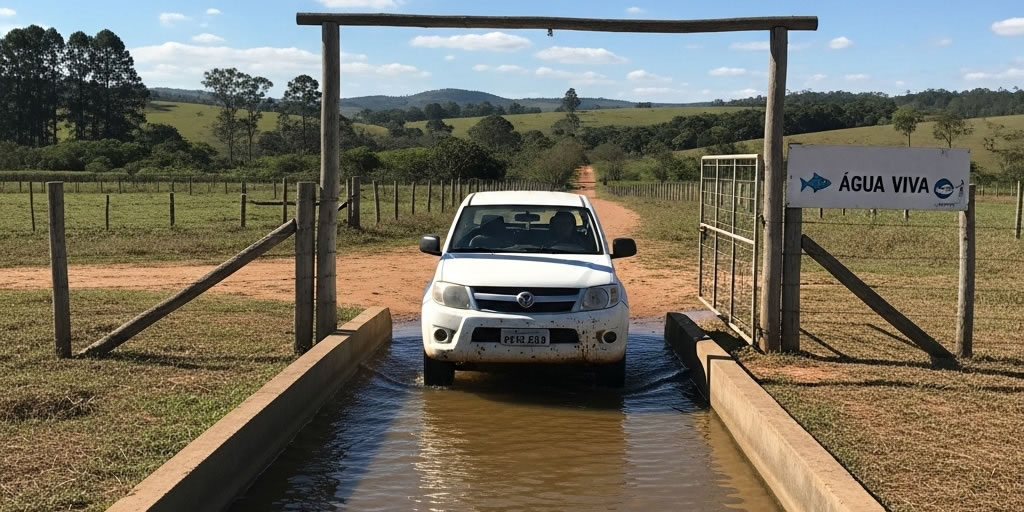- Software Gestor para Aquicultura
- (85) 2139-6730
- contato@despesca.com.br
The Complete Guide to Biosecurity in Aquaculture: From Checklist to Action

Early Detection: How to Identify Signs of Stress and Disease in Fish and Shrimp and Act Fast
29/08/2025
Leaving the Farm Gate: How to Create Your Own Brand and Sell Shrimp Directly to the Consumer
02/09/2025The introduction of diseases on an aquaculture farm is one of the greatest risks to production, capable of decimating stocks and causing severe financial losses. A robust biosecurity program is not a luxury, but a fundamental pillar for the sustainability and profitability of the business. It is a set of preventive practices that create barriers against the introduction and spread of pathogens.
Success lies not in sporadic actions, but in the consistent application of a well-defined protocol. This detailed guide serves as a practical manual to strengthen your farm’s defenses.
1. Access Control: Your Farm’s Fortress
The first and most critical line of defense is strict control over everything that enters the production area.
- Demarcation and Signage: The production area must be clearly demarcated with fences and marked with “Restricted Access” signs.
- Single Entry Point: Centralize the entry and exit of vehicles and people at a single controlled gate.
- Active Sanitary Barriers: Install and maintain footbaths (for footwear) and wheelbaths (for tires) with effective disinfectant solutions. The solution should be changed every 2-3 days or whenever it shows excess organic matter.
- Visitor Log: Keep a detailed record of all visits. A digital system makes it easier to consult and track in case of an outbreak.
- Animal Control: Implement measures to prevent access by birds, capybaras, and domestic animals, which are potential disease vectors.
2. Animal Acquisition: The Highest Risk Point
The introduction of new post-larvae or juveniles is the most likely moment for a pathogen to enter. Attention here must be doubled.
- Certified Suppliers: Purchase animals only from reputable laboratories that have health certificates and perform PCR analysis for the main diseases of the species.
- Mandatory Quarantine Protocol: Never introduce a new batch directly into the grow-out ponds. Quarantine is a non-negotiable step.
Executing an Effective Quarantine Protocol
Quarantine serves to acclimate the animals and observe if they manifest any disease before coming into contact with the rest of the stock.
- Isolated Structure: Use smaller tanks or ponds, completely isolated from the main production system, with independent water supply and drainage.
- Duration: The minimum recommended period is 15 to 30 days.
- Observation and Analysis: Monitor behavior, feeding, and mortality daily. If possible, send samples for laboratory analysis at the beginning and end of the quarantine period.
- Stress Test: At the end of the period, perform a stress test (e.g., controlled reduction of oxygen or change in salinity) to induce the manifestation of diseases in asymptomatic carriers. Only animals that withstand the test well should be approved for stocking.
3. Cleaning and Disinfection: Breaking the Contamination Cycle
Shared equipment is an express route for spreading diseases between ponds.
- Dedicated Equipment: Designate nets, buckets, hand nets, and other utensils for exclusive use in each pond, or at least in each sector of the farm. Identify them with different colors.
- Preliminary Cleaning: Disinfection is only effective on clean surfaces. Always wash equipment with clean water and a brush to remove all organic matter before disinfecting.
- Proper Storage: After disinfection and rinsing, store the equipment in a dry, protected place, away from dirty materials.
Technology and Professional Support: The Duo for Success
Controlling all these protocols requires discipline and organization. A management software like Despesca is indispensable for turning the plan into action, allowing you to schedule tasks, track batches, and monitor parameters in a centralized and efficient way.
However, technology alone does not replace specialized technical knowledge.
The Importance of a Qualified Professional
Each farm has unique challenges, influenced by its location, cultivated species, production system, and water sources. Therefore, it is crucial to have the support of a qualified professional, such as a fisheries engineer, zootecnician, or veterinarian with experience in aquaculture.
This specialist will be able to:
- Customize the Plan: Adapt this general biosecurity guide to the specific reality of your property.
- Diagnose Accurately: Correctly identify diseases in their early stages, which is crucial for effective intervention.
- Prescribe Treatments: Recommend the correct and legal use of medications and chemical products, avoiding improper management that could worsen the problem or harm the crop.
- Provide Strategic Guidance: Offer a technical vision to optimize production as a whole, from nutrition to water management.
Implementing a detailed biosecurity program, managing it with technology, and validating it with expert guidance is the smartest strategy to protect your investment, ensure the health of your animals, and secure productivity cycle after cycle.



